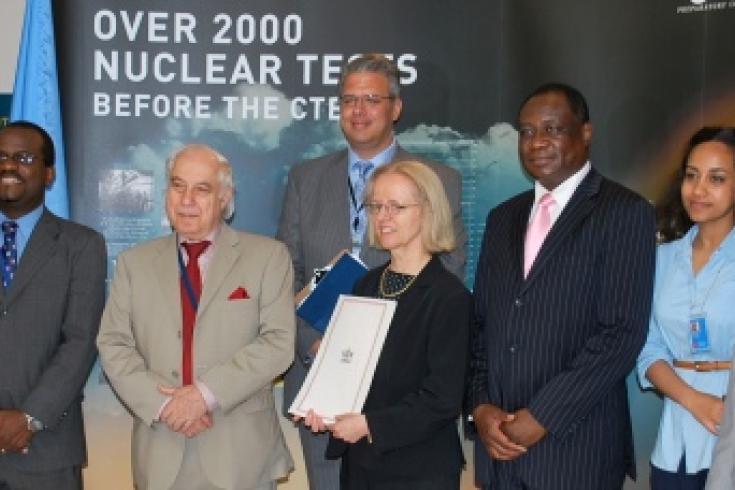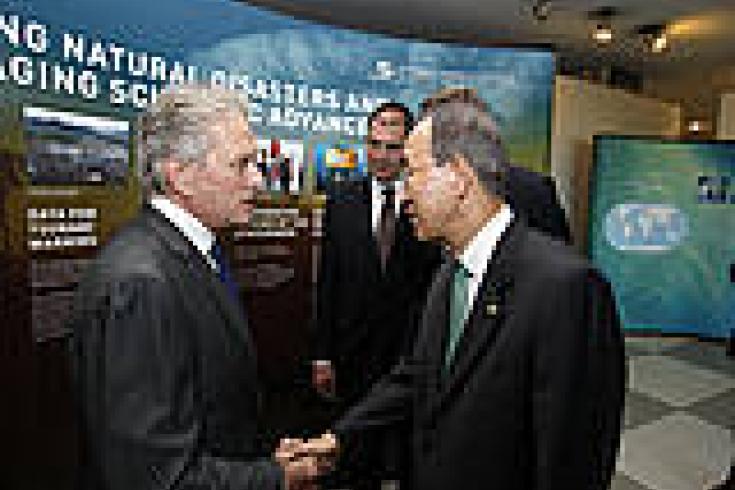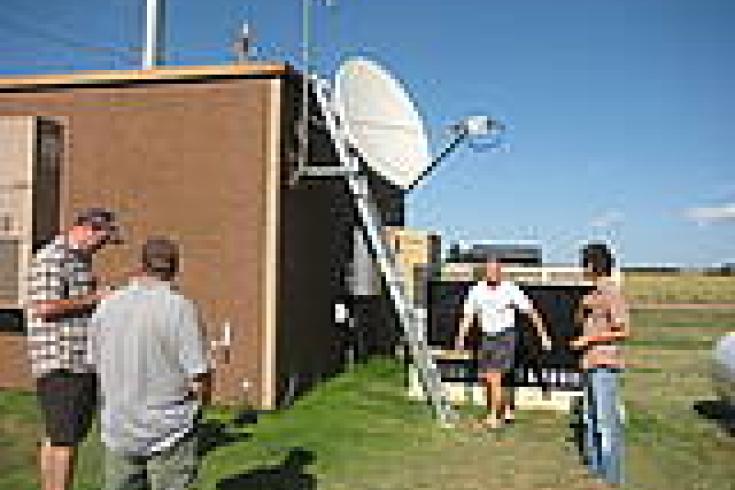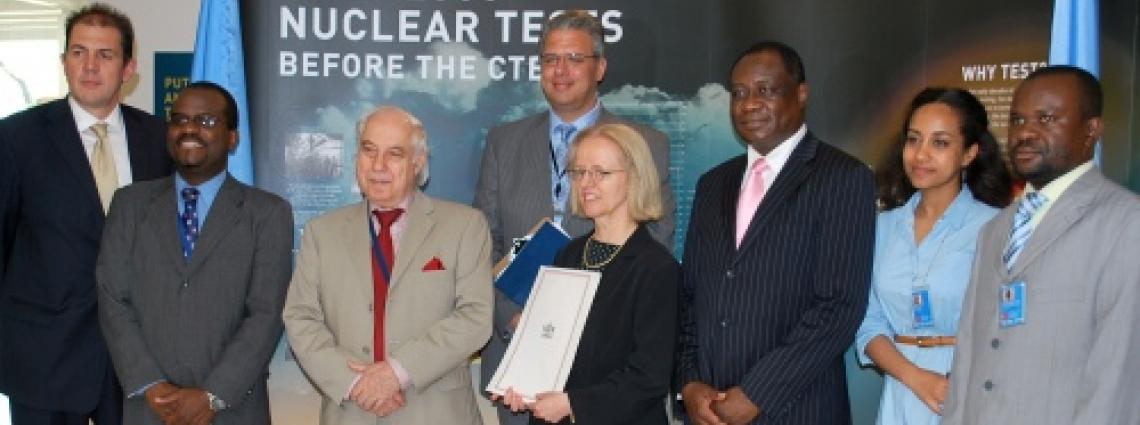Annual Highlights2010: CTBTO continuesto make headway
The final year in the first decade of the 21st century has been one of “remarkable achievements” says Tibor Tóth, Executive Secretary of the Preparatory Commission for the Comprehensive Nuclear-Test-Ban Treaty Organization (CTBTO). In the past decade, the Treaty’s monitoring system has expanded to its current status of 263 certified facilities from zero in 2000, he said. Just 10 years ago there were 51 ratifications. In 2010 with the ratifications by Trinidad and Tobago and by the Central African Republic the number has tripled to 153 ratifications and the Treaty has been signed by 182 States. The achievements are being driven by “a vision to bring an end to the era of nuclear weapons,” Tóth said.

Sergio Duarte, UN High Representative for Disarmament Affairs, with CTBTO, UN, and Central African Republic representatives
Growing Support
The new ratifications entered into law two days before the successful outcome of the 2010 NPT Review Conference, or on 26 May when they were presented at the United Nations headquarters in New York. On the eve of the Conference Indonesia had announced its intention to ratify the Treaty. During the Conference, four more CTBT signatories, Iraq, Papua-New Guinea, Thailand, and the United States, also declared their intention to move forward with their ratifications.
As the Conference gathered momentum, an exhibition illustrating the history of nuclear testing and the path to adopting the CTBT opened in the UN headquarters on 4 May. “Putting an end to nuclear explosions is more than the name of this exhibition – it is one of the longest-standing goals of the United Nations,” UN Secretary General Ban Ki-moon declared.
Actor/producer and UN Messenger of Peace Michael Douglas said there was no reason “our children” should live in the shadow of “these terrible weapons.” His appeal that “the necessary steps can be taken now,” were echoed by Indonesia’s Foreign Minister Marty Natalegawa, who said that his country believed it could enhance its contribution to nuclear disarmament by acting now to begin the process of ratifying the CTBT.
In April when Natalegawa first announced his country’s decision Tóth said: “this underscores the leadership role of Indonesia in regional and global non-proliferation and disarmament efforts.”
The NPT Review Conference as well as breaking a decade of political deadlock adopted an action plan giving strong support for the CTBT, an outcome warmly received by Tóth.
Support for the Treaty in 2010 also came from the UN General Assembly, which gave strong endorsement of the CTBT. The Russian Federation and the United States introduced for the first time a resolution on bilateral strategic arms reductions including recognition for early entry into force of the CTBT. Earlier in the year the new Nuclear Posture Review released by the US clearly underlined the importance of the CTBT.
The 23 September Joint Ministerial Statement
launched by Foreign Ministers at the Fifth Ministerial Meeting to promote early entry-into-force of the CTBT was another strong political message in favour of the Treaty. The CTBTO also deepened cooperation with its pool of partners. In February UNESCO and the CTBTO signed an agreement to enhance disaster mitigation efforts and capacity-building in developing countries.
In November support for the Treaty was voiced by Nobel Peace Prize laureates, at their meeting in Hiroshima. They urged the remaining nine countries, whose ratification will bring the CTBT into force, to act now.

UN Secretary-General Ban Ki-moon and UN Messenger of Peace Michael Douglas at the CTBTO exhibition in New York, May 2010.
An unparalleled system of verification nearing its completion
The architects of the CTBT made no concessions to the standards it sets for verification. Very high system capabilities and performance, as well as a rigorous certification process are required for each station. At the end of 2010 there were 264 stations in the International Monitoring System (IMS), representing more than 80 per cent completion of its system of 337 stations. Six new facilities were certified in the Russian Federation alone in 2010. In August the first noble gas monitoring station was officially integrated into the system in the United States.
The International Data Centre (IDC) in January 2010 completed a five-year project to renew its computer system with a migration to Linux systems. New global communications infrastructure is also in place and fully operational providing higher availability and reliability of data.
In November 2010 the CTBTO staged a simulated on-site-inspection beside the Dead Sea, in Jordan. A team of 35 experts from 20 countries participated in the exercise, preparation for conducting on-Site Inspections, which will form a major component of the verification regime, available to Member States, when the Treaty enters into force.
The CTBTO is giving priority to training experts from Member States. A series of national and regional workshops and seminars were held, as well as training at the Vienna Headquarters and on-line. Many courses offer Member States the technical capabilities to better access and use data collected by the CTBTO’s global monitoring system. Every day 10 gigabytes of data flows into the Vienna headquarters of the CTBTO and is made available to all Member States on an equal basis.
The CTBTO’s verification network also provides significant civil benefits. In November France became the eighth country to sign an agreement with the CTBTO on receiving tsunami warning data.

The noble gas system at the monitoring station RN74 in Ashland, Kansas, is part of the International Noble Gas Experiment (INGE) and will soon be certified.
An investment of unique value to be stewarded
The continuous expansion, upgrading and maintenance of a vast, state-of-the-art global monitoring network and communications infrastructure, represents an unprecedented joint investment. Since the Treaty opened for signature in 1996 almost $1 billion has been invested by Member States in the verification regime.
The CTBTO’s annual budget, of $115,579,600 (€80,601,500) in 2010, remains below zero real growth, and its level of staff remains unchanged since 2003. “Managing the onerous increase in the workload with a constant level of resources has been a serious challenge,” Tóth told representatives of CTBTO Member States at a regular meeting of the CTBTO’s executive body in November.
In December the rate by which Member States pay their assessed dues stood at 85% compared to last year’s rate of 79%. It is crucial for all Member States to fulfill their financial obligations in full, on time and without condition. Frank Becker, Permanent Representative of Belgium, speaking on behalf of the European Union, told the CTBTO executive body meeting in November. In 2010 an extra-budgetary contribution of €5.3 million was made by the European Union to strengthen CTBTO monitoring and verification capabilities, including its cooperation with the scientific community.

“Managing the onerous increase in the workload with a constant level of resources has been a serious challenge,” Tibor Tóth said.
The defining factor
Addressing the 2010 World Summit of Nobel Peace Laureates in Hiroshima on 13 November Tóth said: “in 2010, the international community clearly reaffirmed its resolve to move forward. Several high level events and pronouncements by world leaders provided a new sense of optimism. They were also a reminder that multilateralism has not withered away; that multilateral action to face common challenges is indeed still possible. It is perhaps the only way forward in a world of increasing complexity.”
Addressing the United Nations General Assembly
on December 13, Tóth said: “the CTBT is clearly of great significance for the global disarmament and nonproliferation regime. It has a key role to play in today’s security environment. More than two thousand tests were conducted prior to the Treaty’s conclusion in 1996. Every test eroded global security, and widened the gap in political trust. In the last decade, there have only been two nuclear test explosions. The difference is clear. But it is high time for concrete action. The entry into force of the Treaty may be the single defining factor for the nuclear nonproliferation regime in the next 30 years,” Tóth said.

The Executive Secretary of the Preparatory Commission for the Comprehensive Nuclear-Test-Ban Treaty Organization, Tibor Tóth.
